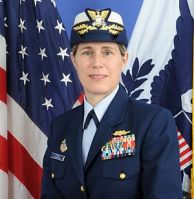
Rear Admiral Sandra Stosz
National Public Radio (NPR) recently did a segment on the U.S. Coast Guard Academy and its new superintendent, Rear Admiral Sandra Stosz. The Coast Guard has been at the forefront of expanding opportunities for women since 1977 when it opened all of its jobs to women. It even decided to admit women to the Coast Guard Academy in 1975, before the Department of Defense was ordered to so by Congress. And although it’s the smallest military service (though not part of the Department of Defense, it is still considered a military service), it has huge responsibilities for the safety and security of our country. And Coast Guard women are at the forefront of that fight.
The glass-ceiling-breaking example pioneered by the Coast Guard is important to acknowledge — and understand — because it shows just what is possible. Advancement of women in the Coast Guard has become something of a non-story simply because it is a regular part of the way it conducts business. Those of us who blazed our own trails inside the U.S. military like to highlight such achievements, hoping that the other military services will embrace such lessons and apply them to their own ranks.
RADM Stosz is not only the first women to be superintendent of the Coast Guard Academy, she is also the first woman to be superintendent of any military academy. Prior to her appointment earlier this year, the closest any woman got to that position was Captain (now Rear Admiral) Margaret Klein, who was commandant of cadets at the Naval Academy prior to her flag officer selection. The first woman to command a military vessel also occurred in the Coast Guard. In 1979, then Lieutenant (j.g.) Beverly Kelly commanded the USCGC Cape Newagen, a 95-foot cutter with a crew of 14 men. Twenty years later, she made history again as the first woman to command a Coast Guard medium-endurance cutter, the USCGC Northland.
RADM Stosz is a sea-going officer, and incidentally the first female Coast Guard Academy Graduate (class of 1982) to become a flag officer, as well as the first — and to date, only — female flag officer in the Coast Guard with at-sea experience. She has 12 years afloat, including command of two cutters – an icebreaking tug on the Great Lakes and a medium endurance cutter that patrolled North Atlantic and Caribbean waters.
The Coast Guard has also seen women at high levels in the chain of command. Vice Admiral Vivian Crea, an aviator, was the first woman to be appointed as vice commandant of the Coast Guard, from 2006 to 2009. The vice commandant is second in command of the entire Coast Guard, as well as its chief operating officer. As a lieutenant commander, Crea was also the first woman, as well as the first Coast Guardsman, to serve as a military aide to a president — in her case, Ronald Reagan. Following in her footsteps is Vice Admiral Sally Brice-O’Hara, who is currently serving as the service’s second-ranking officer. No other military service has had any woman — much less two — advance so close to the peak of the service’s command.
So it was fitting that NPR opted to focus on the Coast Guard. Meanwhile, women wait to be allowed in all billets in the Department of Defense, and wait to be selected to higher-level positions, including as chiefs of staff of the Army or Air Force, commandant of the Marine Corps, or chief of naval operations. But all that appears to be a long way off. This is primarily because women have only been allowed to serve in combat positions at sea and in the air since 1993-94, unlike the Coast Guard who opened all billets in 1977. Women in the Army and Marine Corps are still barred from serving at the tip of the spear — the infantry, artillery, and armor units — in which many future leaders serve. So let’s hear it for the Coast Guard, and its opportunities for women. Just as it has guided sailors for centuries, may it also guide, and enlighten, its sister services on promoting women into the top ranks!


